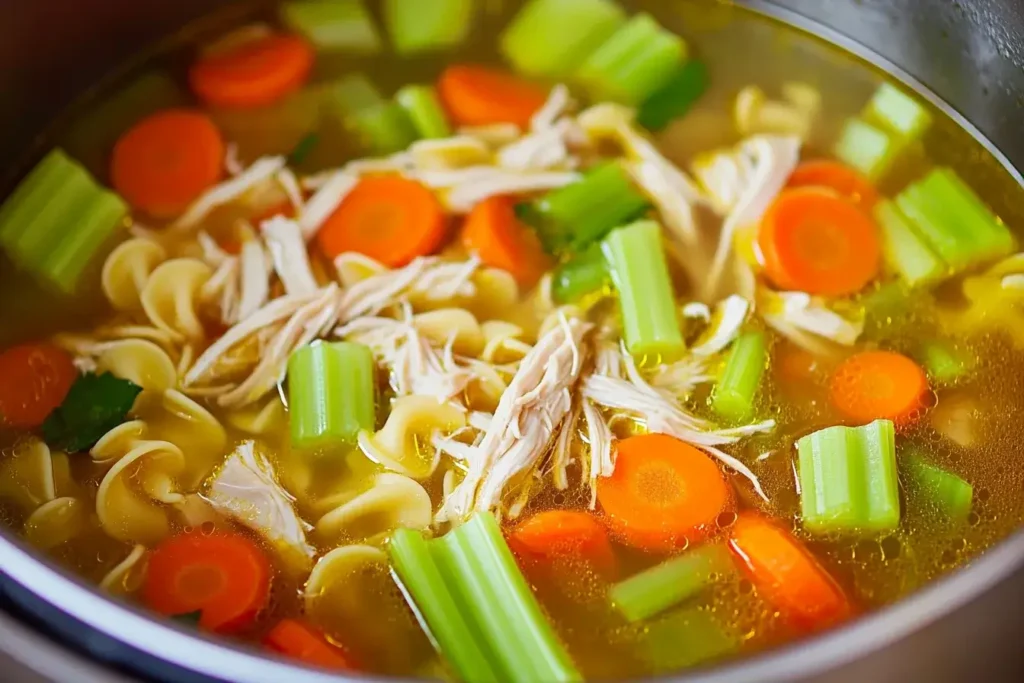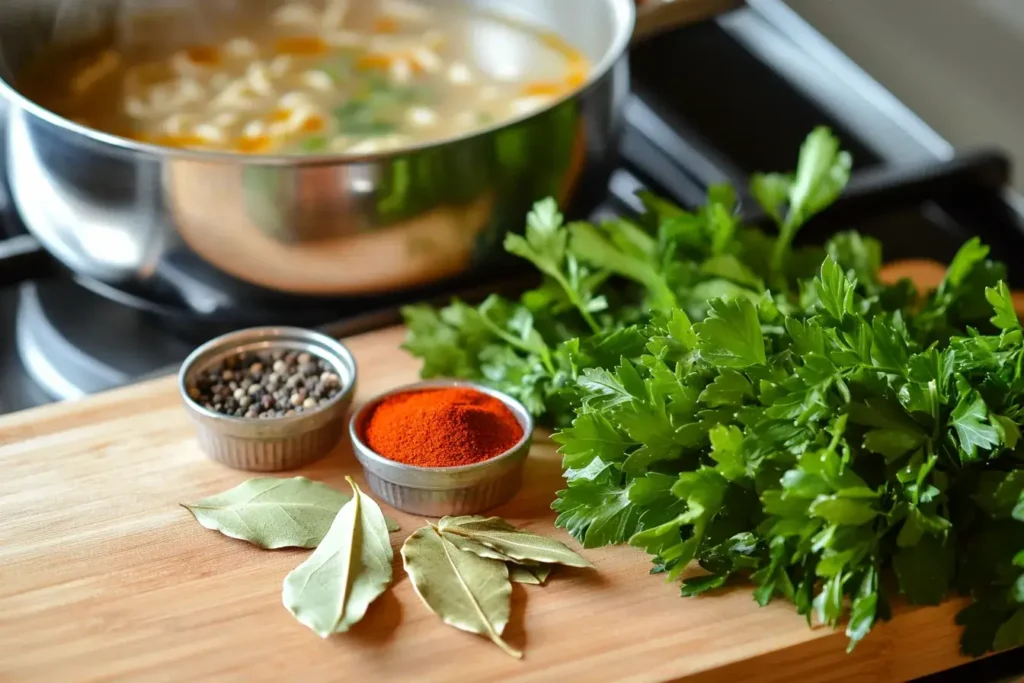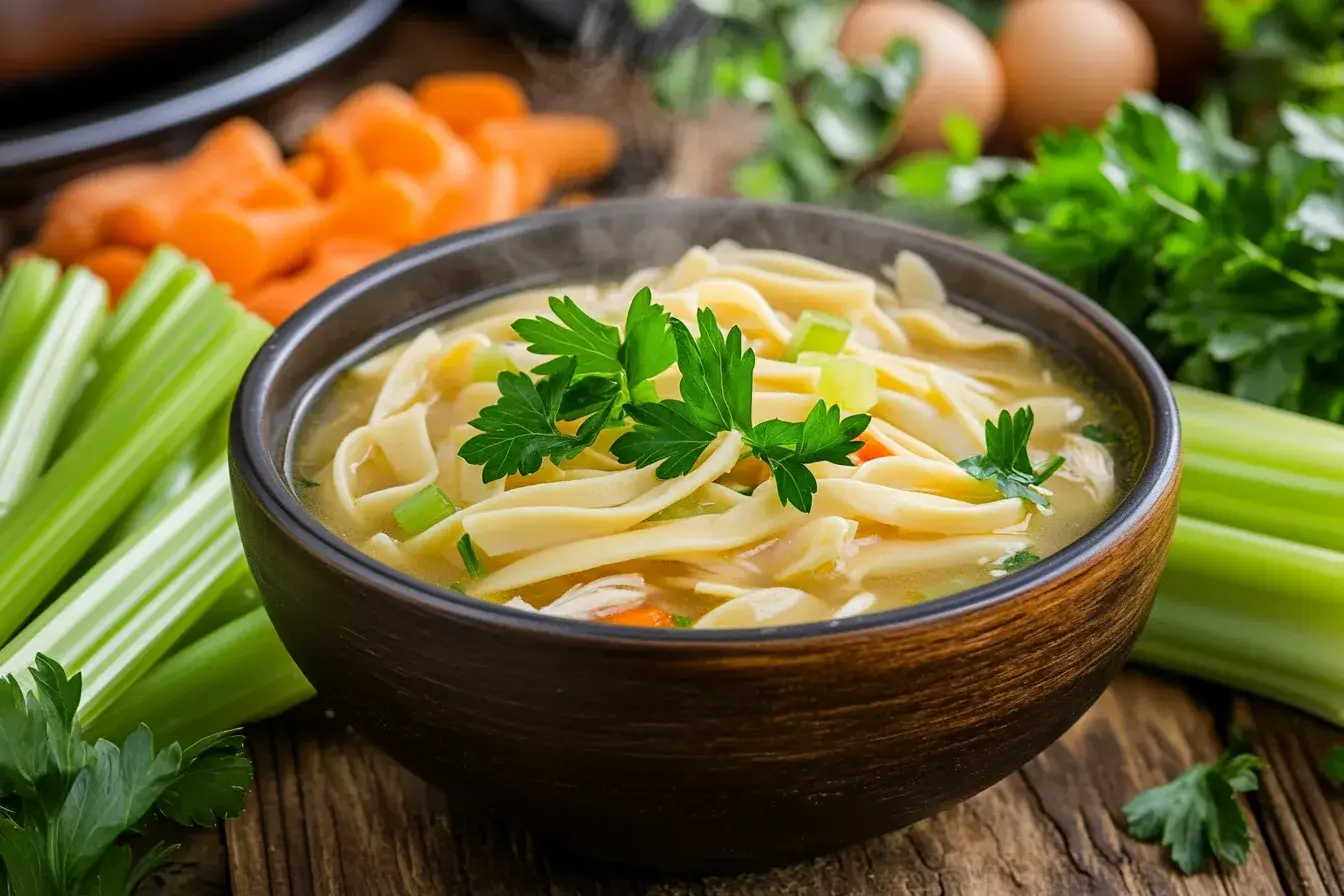Chicken noodle soup isn’t just a meal—it’s a tradition, a memory, and often, a remedy for both the body and soul. And when it’s grandma’s chicken noodle soup, the experience becomes even more special. From its rich, savory aroma wafting through the house to its comforting warmth on a chilly day, this dish is steeped in nostalgia. This article dives deep into the legacy, preparation, and timeless appeal of grandma’s chicken noodle soup. Along the way, you’ll discover tips, tricks, and variations to make it just right for your table.
The Legacy of Grandma’s Chicken Noodle Soup
The Heartwarming History of Chicken Noodle Soup
Chicken noodle soup has been around for centuries, with its roots traced back to early cultures where broth-based meals symbolized both health and hospitality. It’s no surprise that grandma’s chicken noodle soup became a staple in family kitchens worldwide. From European households to Asian kitchens, each region has its version, but they all share one thing in common: they warm the heart and soul.
Why Grandma’s Chicken Soup Recipe is the Best
What makes grandma’s chicken noodle soup so special? It’s not just the recipe; it’s the love and care poured into each pot. While recipes might call for basic ingredients like chicken broth, vegetables, and noodles, grandma always seemed to have a magic touch—whether it was her secret seasoning, the way she simmered the broth, or the comforting smile she served alongside it.
Cultural Variations of Classic Chicken Soup
Chicken noodle soup transcends borders. In the United States, it’s a go-to comfort food during cold and flu season. In China, a similar dish, chicken noodle congee, serves as a staple for rejuvenation. Eastern European variations often include dill and hearty dumplings, showcasing how each culture puts its unique spin on this timeless dish. Yet, no matter the version, the essence of grandma’s chicken noodle soup remains universal—love and nourishment in a bowl.
The Ingredients for Perfect Chicken Noodle Soup
Choosing the Best Chicken for Homemade Chicken Noodle Soup
The foundation of grandma’s chicken noodle soup lies in the chicken. Whether you opt for fresh chicken, smoked varieties, or the convenience of rotisserie chicken, the choice profoundly affects the flavor. Fresh chicken provides a mild, classic taste, while smoked chicken infuses a rich, savory depth. Rotisserie chicken, on the other hand, offers a time-saving alternative without compromising the comforting essence of the dish. For tips on preparing chicken with marinades, explore this Asian chicken marinade guide.
Essential Vegetables for a Classic Chicken Soup Recipe
A colorful medley of vegetables is at the heart of grandma’s chicken noodle soup. Celery, onions, and carrots not only add vibrant color but also bring layers of flavor and vital nutrients. For added variety, consider tossing in seasonal vegetables like zucchini or spinach. A mix of herbs such as parsley, thyme, or dill can amplify the aroma, transforming your soup into an unforgettable experience.
Why Egg Noodles Make Grandma’s Chicken Noodle Soup Special
No bowl of chicken noodle soup is complete without noodles, and egg noodles are the traditional choice for good reason. They soak up the broth beautifully and offer a soft, satisfying bite. However, for those looking to experiment, consider pasta shells or gluten-free alternatives. Egg noodles pair seamlessly with the rich, savory broth and vegetables, embodying the essence of comfort in every spoonful.
How to Make Grandma’s Chicken Noodle Soup
Step-by-Step Guide to Preparing the Base
Start by creating a robust base using chicken broth. Simmer the broth with a mix of herbs like rosemary and bay leaves for depth. Add finely chopped onions, celery, and carrots to infuse the base with fresh, aromatic flavors. As the vegetables soften, the broth transforms into the soul of grandma’s chicken noodle soup.
Tips for Perfectly Cooked Noodles
Timing is everything when it comes to noodles. Overcooked noodles can turn mushy and absorb too much broth. To avoid this, cook them separately and add them just before serving. For a more integrated flavor, you can simmer them briefly in the soup before serving.
Balancing Seasoning: Achieving That Homey Taste
The hallmark of grandma’s chicken noodle soup is its perfectly balanced seasoning. A touch of poultry seasoning, salt, and a dash of pepper are essential. Adjust to taste, ensuring the broth complements rather than overpowers the chicken and vegetables. A squeeze of lemon juice can add a zesty finish to elevate the overall flavor.
Variations for Dietary Preferences
Whether catering to gluten-free, vegetarian, or keto diets, the soup can be easily modified. Substitute traditional egg noodles with gluten-free pasta, or replace chicken with tofu or chickpeas for a vegetarian version. For keto-friendly options, use zoodles or shirataki noodles.

Enhancing the Flavor
Spices and Herbs to Elevate the Soup
A simple bowl of grandma’s chicken noodle soup can be transformed with the right spices and herbs. While the classic recipe uses poultry seasoning and bay leaves, adding fresh thyme, dill, or a pinch of paprika can create a flavor boost. For an added kick, consider a dash of cayenne pepper or minced garlic. Freshly chopped parsley or cilantro sprinkled just before serving adds a refreshing finish.

Secret Ingredients You Can Add
Every grandma seems to have a secret ingredient that makes her soup unforgettable. From a splash of soy sauce for umami depth to a teaspoon of white wine for subtle sweetness, these small tweaks can elevate the dish. Another pro tip? Add a touch of grated parmesan or a dollop of cream for a richer texture. Experimenting with these secret touches can make grandma’s chicken noodle soup uniquely yours.
Pairing Suggestions: Breads, Salads, and More
Pairing the soup with the right side dish makes it a full meal. A crusty baguette or soft dinner rolls are classic choices. For something lighter, a fresh green salad with a tangy vinaigrette complements the soup’s warmth perfectly. Want something heartier? Consider serving it with a side of creamy shrimp pasta for a cozy, indulgent dinner.
Common Mistakes to Avoid
Overcooking Noodles: Why Timing Matters
One of the most common pitfalls when making grandma’s chicken noodle soup is overcooking the noodles. Overcooked noodles not only lose their structure but can also absorb excessive amounts of broth, leaving the soup overly thick, dry, and unappetizing. Additionally, mushy noodles can detract from the overall enjoyment of the dish, making it less appealing for leftovers. To prevent this, cook the noodles separately in salted water until just al dente, and then rinse them under cold water to halt the cooking process. Add them to the soup just before serving, giving them enough time to soak up the flavors without turning soggy. This simple technique ensures the noodles retain their bite and complement the soup’s rich, hearty broth perfectly. For meal prep or batch cooking, keeping the noodles separate until the last minute also helps maintain the soup’s quality over time.
Balancing Saltiness: Tips from Experts
Adding too much salt can quickly overpower the delicate flavors of the soup. Start with a conservative amount and adjust as needed after all ingredients have simmered. If the soup becomes too salty, a few potato slices simmered in the broth can help absorb the excess salt.
Storing Leftovers Without Losing Flavor
Storing leftovers can be tricky. Noodles tend to soak up liquid when stored in the soup. To avoid this, keep noodles and broth in separate containers. Reheat them together just before serving. This method preserves the texture and taste of grandma’s chicken noodle soup, even after a day or two in the fridge. If you plan to freeze the soup, store the noodles and broth separately in freezer-safe containers to maintain the best quality. When ready to enjoy, thaw and reheat the broth, cooking fresh noodles to add in for a delicious, just-made taste.
Health Benefits of Chicken Noodle Soup
Nutritional Value of Grandma’s Recipe
A bowl of grandma’s chicken noodle soup is more than comfort food—it’s a powerhouse of nutrition. Packed with protein from tender chicken, it helps repair tissues and boost immunity. The vegetables, like carrots and celery, provide essential vitamins, including vitamin A for eye health and vitamin C for a stronger immune system. Meanwhile, the broth keeps you hydrated and helps soothe sore throats, making it a perfect remedy during cold and flu season.
Why It’s a Go-To Comfort Food During Sickness
There’s a reason chicken noodle soup has been dubbed “nature’s penicillin.” The hot broth helps clear nasal passages, while its warm, savory flavor provides much-needed comfort. Grandma’s chicken noodle soup is especially effective because it’s made with fresh, wholesome ingredients. Studies suggest that chicken soup may also have mild anti-inflammatory effects, reducing congestion and easing symptoms of respiratory infections.
Whether you’re feeling under the weather or simply craving a nourishing meal, this soup is the perfect pick-me-up.
Grandma’s Soup Through Modern Eyes
Adapting the Recipe for Today’s Kitchens
In today’s busy world, many home cooks look for shortcuts without sacrificing flavor. Modern twists on grandma’s chicken noodle soup include using slow cookers or Instant Pots to save time. These tools allow the flavors to meld while you attend to other tasks. Pre-cooked rotisserie chicken or store-bought broth can also streamline the process without losing the homemade touch.
For those seeking healthier options, adding superfoods like kale or quinoa can boost the nutritional value. These additions complement the soup’s traditional ingredients while offering a contemporary take on a timeless dish.
Keeping the Tradition Alive for Future Generations
Passing down grandma’s chicken noodle soup recipe is more than sharing a meal—it’s preserving a family legacy. Encourage younger generations to participate in the cooking process, sharing stories and tips along the way. Whether it’s teaching the importance of seasoning or the joy of simmering broth, these moments create lasting memories.
By adapting the recipe to suit modern tastes and tools, you ensure that this comforting classic continues to warm hearts and homes for years to come.
Frequently Asked Questions (FAQs)
Can I Freeze Grandma’s Chicken Noodle Soup?
Absolutely! Grandma’s chicken noodle soup freezes beautifully, making it a convenient option for meal prepping or saving leftovers. To avoid soggy noodles, store them separately from the broth in airtight containers. This keeps the broth flavorful and the noodles firm. When you’re ready to eat, simply reheat the broth until it’s steaming hot and add freshly cooked or thawed noodles. This method ensures the soup tastes just as delicious as the day it was made.
How Can I Make It Gluten-Free?
To make a gluten-free version of grandma’s chicken noodle soup, swap traditional egg noodles for gluten-free pasta or zucchini noodles. Quinoa or rice noodles are also excellent alternatives that retain their texture. Additionally, ensure that your chicken broth is gluten-free by carefully checking the label for any hidden gluten ingredients. With these small changes, you can enjoy all the comfort and flavor of this classic soup without worrying about dietary restrictions.
What’s the Best Way to Reheat the Soup?
The best way to reheat grandma’s chicken noodle soup is on the stovetop over medium heat. This method gently warms the soup, retaining its original flavor and texture without overcooking the chicken or noodles. If you’re in a hurry, use the microwave, but heat the soup in short 30-second intervals, stirring in between, to prevent uneven heating or loss of moisture. For best results, add a splash of water or broth to maintain the perfect consistency.
Conclusion
Grandma’s chicken noodle soup isn’t just a recipe; it’s a story—a narrative of warmth, care, and tradition. From its humble beginnings as a simple, wholesome dish to its modern adaptations, this soup has remained a symbol of comfort and nourishment. Whether you’re savoring it on a cold day, serving it to a loved one who’s feeling under the weather, or simply craving something hearty, this timeless dish never fails to deliver.
As you prepare your own version, remember to add your personal touch. Maybe it’s a pinch of an unusual spice, a family secret ingredient, or simply the love you pour into the pot. In the end, the magic of grandma’s chicken noodle soup lies in its ability to bring people together, one bowl at a time.

